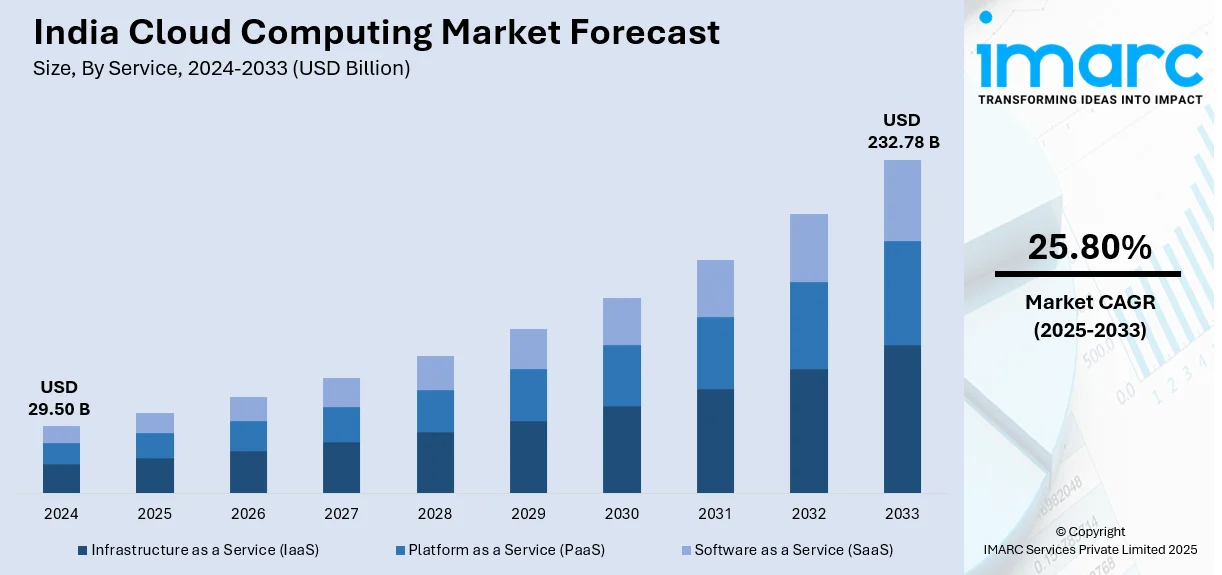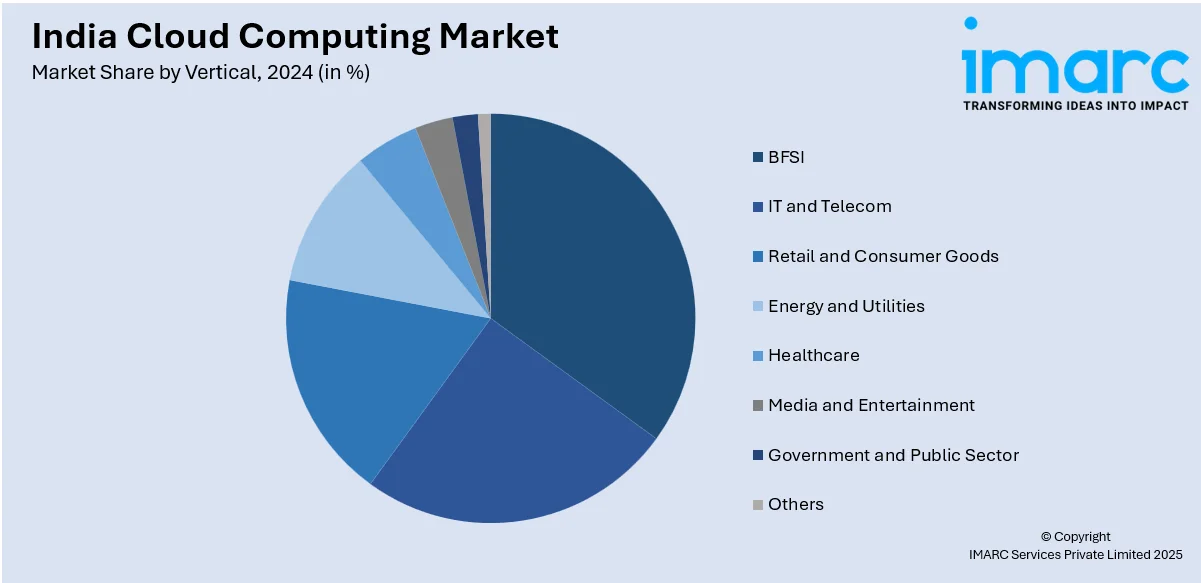
India Cloud Computing Market Size, Share, Trends and Forecast by Service, Workload, Deployment Mode, Organization Size, Vertical, and Region, 2025-2033
India Cloud Computing Market Overview:
The India cloud computing market size reached USD 29.50 Billion in 2024. Looking forward, IMARC Group expects the market to reach USD 232.78 Billion by 2033, exhibiting a growth rate (CAGR) of 25.80% during 2025-2033. The market is growing due to rising digital transformation, increasing AI and big data adoption, government initiatives like Digital India, cost efficiency, demand for hybrid cloud solutions, expanding data center infrastructure, and strong enterprise cloud adoption.
|
Report Attribute
|
Key Statistics
|
|---|---|
|
Base Year
|
2024 |
|
Forecast Years
|
2025-2033
|
|
Historical Years
|
2019-2024
|
| Market Size in 2024 | USD 29.50 Billion |
| Market Forecast in 2033 | USD 232.78 Billion |
| Market Growth Rate (2025-2033) | 25.80% |
India Cloud Computing Market Trends:
Government Initiatives and Regulatory Support
Government-led programs such as Digital India, Startup India, and Make in India are boosting cloud adoption across enterprises and public sector organizations. Policies promoting data localization and cloud-first strategies for government projects are creating demand for domestic cloud services. The introduction of the Personal Data Protection Bill (PDPB) and sectoral data regulations are further driving businesses to invest in secure, compliant cloud infrastructure. Additionally, the expansion of smart cities, e-governance services, and cloud-based public service delivery is increasing the reliance on cloud platforms, strengthening the overall India cloud computing market growth. For instance, in November 2024, The Reserve Bank of India (RBI), the central bank of India, intends to launch a pilot initiative in 2025 aimed at delivering cost-effective local cloud data storage solutions to financial institutions. This initiative will involve the RBI collaborating with local IT firms, competing with major global cloud service providers like Amazon Web Services (AWS), Microsoft Azure, Google Cloud, and IBM Cloud. The market for cloud services in India was estimated at US$ 8.3 billion (~Rs. 68,890 crore) in 2023, with projections indicating it will hit US$ 24.2 billion (~Rs. 2,00,860 crore) by the year 2028.

Growing AI, Big Data, and IoT Adoption
The combination of cloud computing with artificial intelligence (AI), machine learning (ML), big data analytics, and the Internet of Things (IoT) is fueling the need for scalable and high-performance cloud platforms. Companies use cloud-based artificial intelligence and analytical services to get fast insights and automated operations solutions that improve user interactions which are creating a positive India cloud computing market outlook. Cloud infrastructure requires significant expansion because organizations increase their usage of connected devices and smart infrastructure as well as edge computing deployments. Cloud solutions help businesses manage massive datasets, optimize supply chains, and improve predictive analytics, making the cloud a critical enabler of India’s digital economy. For instance, in November 2024, Qlik, a data integration, analytics, and artificial intelligence (AI) services provider, announced the introduction of a new cloud region in India. The cloud, based in Mumbai, is intended to meet the growing demand for local data storage, regulatory compliance, and sophisticated AI capabilities, according to the Pennsylvania-based corporation.
Expanding Data Center Infrastructure and Cloud Investments
Major cloud service providers such as Amazon Web Services (AWS), Microsoft Azure, and Google Cloud are expanding their data center presence in India to meet growing demand. Domestic companies like Reliance Jio, Tata Communications, and NTT Data are also investing in cloud infrastructure. These developments are reducing latency, improving data security, and enhancing local cloud services. The rise of hyperscale data centers, increased fiber optic connectivity, and improved power availability are strengthening cloud capabilities. Enterprises are migrating from on-premise IT systems to cloud-based solutions, boosting overall market growth. For instance, in February 2025, CtrlS, an Indian data center operator, launched its data center campus in Chennai, India, with the opening of its second and final building.
India Cloud Computing Market Segmentation:
IMARC Group provides an analysis of the key trends in each segment of the market, along with forecasts at the regional level for 2025-2033. Our report has categorized the market based on service, workload, deployment mode, organization size, and vertical.
Service Insights:
- Infrastructure as a Service (IaaS)
- Platform as a Service (PaaS)
- Software as a Service (SaaS)
The report has provided a detailed breakup and analysis of the market based on the service. This includes Infrastructure as a Service (IaaS), Platform as a Service (PaaS), and Software as a Service (SaaS).
Workload Insights:
- Application Development and Testing
- Analytics and Reporting
- Data Storage and Backup
- Integration and Orchestration
- Resource Management
- Others
A detailed breakup and analysis of the market based on the workload have also been provided in the report. This includes application development and testing, analytics and reporting, data storage and backup, integration and orchestration, resource management, and others.
Deployment Mode Insights:
- Public
- Private
- Hybrid
A detailed breakup and analysis of the market based on deployment mode have also been provided in the report. This includes public, private, and hybrid.
Organization Size Insights:
- Large Enterprise
- Small and Medium Enterprise
A detailed breakup and analysis of the market based on the organization size have also been provided in the report. This includes large enterprise and small and medium enterprise.
Vertical Insights:

- BFSI
- IT and Telecom
- Retail and Consumer Goods
- Energy and Utilities
- Healthcare
- Media and Entertainment
- Government and Public Sector
- Others
A detailed breakup and analysis of the market based on the vertical have also been provided in the report. This includes BFSI, IT and Telecom, retail and consumer goods, energy and utilities, healthcare, media and entertainment, government and public sector, and others.
Regional Insights:
- North India
- South India
- East India
- West India
The report has also provided a comprehensive analysis of all the major regional markets, which include North India, South India, East India, and West India.
Competitive Landscape:
The market research report has also provided a comprehensive analysis of the competitive landscape. Competitive analysis such as market structure, key player positioning, top winning strategies, competitive dashboard, and company evaluation quadrant has been covered in the report. Also, detailed profiles of all major companies have been provided.
India Cloud Computing Market News:
- In January 2024, Microsoft CEO Satya Nadella announced that the company will invest $3 billion (about Rs 25,700 crore) to strengthen its cloud computing and artificial intelligence capabilities in India. The IT behemoth will also train 10 million individuals in AI skills in India by 2030, Nadella stated at a conference attended by startup founders and executives from technology enterprises.
- In February 2025, Grant Thornton Bharat stated that it had formed a strategic relationship with Yotta Data Services to accelerate enterprise adoption of cloud computing, Artificial Intelligence (AI), and Generative AI (GenAI), hence boosting innovation, growth, and competitiveness. Yotta Data Services is a comprehensive digital transformation supplier that provides GPU infrastructure, cloud computing solutions, colocation services, and managed IT services.
India Cloud Computing Market Report Coverage:
| Report Features | Details |
|---|---|
| Base Year of the Analysis | 2024 |
| Historical Period | 2019-2024 |
| Forecast Period | 2025-2033 |
| Units | Billion USD |
| Scope of the Report |
Exploration of Historical Trends and Market Outlook, Industry Catalysts and Challenges, Segment-Wise Historical and Future Market Assessment:
|
| Services Covered | Infrastructure as a Service (IaaS), Platform as a Service (PaaS), Software as a Service (SaaS) |
| Workloads Covered | Application Development and Testing, Analytics and Reporting, Data Storage and Backup, Integration and Orchestration, Resource Management, Others |
| Deployment Modes Covered | Public, Private, Hybrid |
| Organization Sizes Covered | Large Enterprise, Small and Medium Enterprise |
| Verticals Covered | BFSI, IT and Telecom, Retail and Consumer Goods, Energy and Utilities, Healthcare, Media and Entertainment, Government and Public Sector, Others |
| Regions Covered | North India, South India, East India, West India |
| Customization Scope | 10% Free Customization |
| Post-Sale Analyst Support | 10-12 Weeks |
| Delivery Format | PDF and Excel through Email (We can also provide the editable version of the report in PPT/Word format on special request) |
Key Questions Answered in This Report:
- How has the India cloud computing market performed so far and how will it perform in the coming years?
- What is the breakup of the India cloud computing market on the basis of service?
- What is the breakup of the India cloud computing market on the basis of workload?
- What is the breakup of the India cloud computing market on the basis of deployment mode?
- What is the breakup of the India cloud computing market on the basis of organization size?
- What is the breakup of the India cloud computing market on the basis of vertical?
What is the breakup of the India cloud computing market on the basis of region? - What are the various stages in the value chain of the India cloud computing market?
- What are the key driving factors and challenges in the India cloud computing market?
- What is the structure of the India cloud computing market and who are the key players?
- What is the degree of competition in the India cloud computing market?
Key Benefits for Stakeholders:
- IMARC’s industry report offers a comprehensive quantitative analysis of various market segments, historical and current market trends, market forecasts, and dynamics of the India cloud computing market from 2019-2033.
- The research report provides the latest information on the market drivers, challenges, and opportunities in the India cloud computing market.
- Porter's five forces analysis assist stakeholders in assessing the impact of new entrants, competitive rivalry, supplier power, buyer power, and the threat of substitution. It helps stakeholders to analyze the level of competition within the India cloud computing industry and its attractiveness.
- Competitive landscape allows stakeholders to understand their competitive environment and provides an insight into the current positions of key players in the market.
Need more help?
- Speak to our experienced analysts for insights on the current market scenarios.
- Include additional segments and countries to customize the report as per your requirement.
- Gain an unparalleled competitive advantage in your domain by understanding how to utilize the report and positively impacting your operations and revenue.
- For further assistance, please connect with our analysts.
 Inquire Before Buying
Inquire Before Buying
 Speak to an Analyst
Speak to an Analyst
 Request Brochure
Request Brochure
 Request Customization
Request Customization




.webp)




.webp)












